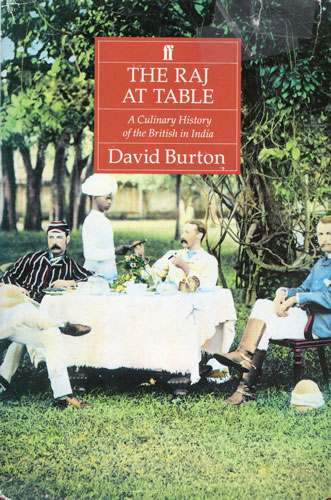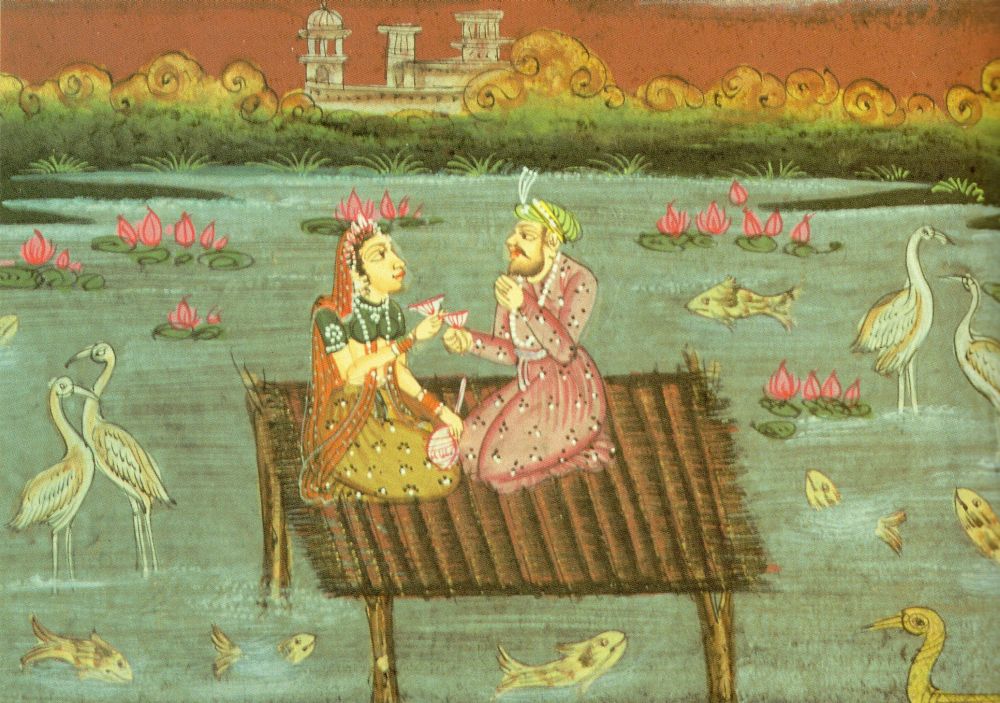The mysteries of Mrs. Framji’s chicken curry, or , an assay into microhistory, embedding a review of The Raj at Table by David Burton.
The Raj at Table by David Burton is by turns fascinating and exasperating. It includes any number of anecdotes about the lives of the British in India under the Raj and also includes a lot of good, varied Anglo-Indian recipes. ( see the Notes) It is worth seeking--the book is out of print--for them alone.
Burton does not, however, include any dishes based on those that originated in the British Isles. Historical cookbooks and kitchen manuscripts, as well as more recent memoirs with and without recipes, indicate that preparations originating there formed a significant component of the Anglo-Indian diet as early as the eighteenth century.
Wyvern’s Indian Cookery Book and other nineteenth century titles by the redoubtable Arthur Robert Kenney-Herbert are among the most famous. Kenney-Herbert was no snob who disdained Indian influence, and his chapters on curry are the best known elements of his writing, but in terms of volume represent only a small proportion of his recipes.

Pat Chapman, founder of the Curry Club in Britain, has written a number of cookbooks, most notably his Taste of the Raj from 1997, that include recipes of recognizably British pedigree modified in the Indian kitchen.
Sometimes roasts and pies were served in the traditional style; most of the time khansamars, or cooks, grafted their own technique onto instructions they received from their memsahibs, who frequently could not cook let alone find the way to the kitchen.
Elsewhere Burton mentions an item but does not provide a recipe, let alone describe it. What is a Poona sausage, and why is, or was, it known by that name? Dumpoke apparently was a popular dish but we do not know why or what it was, either.
Some of his judgments, none of them backed by citation, seem unsound. And then there is the mystery promised in our title, a mystery that casts doubt on the accuracy of Burton’s assertions more generally.
Burton calls the dish in question “Mrs. Framji’s Chicken Curry with Tomatoes” but does not disclose the source of her recipe, let alone give his reader any notion who she was, although to be fair his bibliography does include the entry “Framji, Navroji, Indian Cookery ‘Local’ for Young Housekeepers (Bombay 1883).” Is this the source, and how does Burton know she was married? The title is obscure and until recently was not available outside specialist libraries.
Now, however, it has been published in facsimile and is available on demand from Google books; we obtained ours via the Harvard Book Store. The facsimile raises another question; the bottom of the frontispiece indicates that it was “printed at the Imperial Press” in Bombay “by Navroji Framji.”
From this it appears Framji was the publisher; the claim is explicit. Nowhere within the book (we do not have access to the original cover) is any author literally identified. The practice was not uncommon for cookbooks published under the Raj; in the more snobbish circles of society writing for pay was considered crass, and hiding the name of the author protected her from opprobrium. ‘Anonymous’ therefore frequently appears as the author of household manuals and cookbooks, although, again, not here.

Other problems mar Burton’s attribution of the ‘Local’ to a ‘Mrs. Framji.’ It takes scant research to discover that Navroji is a male name, yet while we know that a woman wrote the Local because references to the “authoress” appear in the preface and elsewhere, we do not in fact know whether she married.
His own usage belies any notion that Burton believed the author of the ‘Local’ was the wife of Mr. Framji. While he does refer to recipes other than the chicken curry as written by ‘Mrs. Framji,’ he also includes recipes attributed to ‘Navroji Framji.’ It would be a stretch to argue that Burton discusses two different people, because his only bibliographical reference to a Framji is the one that misattributes the writing of the ‘Local’ to him. ( compare , for example, ‘Local’ 115 with 134, 138)
The most casual reader of the ‘ Local ’ will note the distinctly British voice of its author, which does not rule out a woman of mixed British and Indian parentage but given its date of publication that appears unlikely, casting further doubt that someone named Framji could have written the book. So Burton appears to have blundered serially in his description of the book, its author and her recipes.
A number of authors who address the food of the Raj provide their readers with lengthy bibliographies; some include the ‘Local’ but the Editor has found none other than Burton who attribute it to a Mrs. Framji. Lizzie Collingham, for example, does not list an author at all, while Cecilia Leong-Salobir, who uses the term to describe someone of British ancestry in India, attributes it to “An Anglo-Indian.”
The ‘Local ’ includes a recipe similar to Burton’s but by no means identical, appropriately also called “Chicken Curry with Tomatoes.” And therein, as they say, lies another spot of rub. In his introduction to The Raj at Table , Burton claims that ‘[m]ost of the recipes in this book have been transcribed as they originally appeared.” Those that “have been rendered into modern idiom” are only some of the ones, he says, that “were either sent to me by men and women who lived in India at the end of the Raj era or have been updated from older recipes to take into account today’s standard weights and measures, food processors and thermostatically controlled ovens.” (Burton xi)
His version of the Framji curry is neither from a manuscript nor does it call for the use of either food processor or oven, and the recipe found in the ‘Local’ is by no means unclear or unworkable. The allegorical separation of church and state in the form of chicken with tomato on the one hand and spicing on the other is Burton’s own; ‘Mrs. Framji’ herself mixes things up in the traditional manner to fry the chicken in the onion, garlic and spice. Then, in the reverse of Burton’s sequence, the tomatoes hit the pot after “a few minutes” under cover.
Perhaps, like Orwell, Burton just made things up when it suited him; perhaps he got confused; perhaps his publishing deadline prevented fact checking. Whatever the reason, something about a good dish of chicken curried with tomato from The Raj at Table has gone wrong. Not, however, Burton’s own recipe; it vanquishes the original and our variant appears in the practical .
Notes:
-The term Anglo-Indian, much like the term creole, or Creole (capitalization confers respect) has multiple meanings and usage can be fraught due to postcolonial political concerns, mostly of the ‘correct’ nature. In this immediate context the term refers to someone of British ancestry living in India whether or not born there. The term also can refer to the forms of the English language written and spoken by Indians in India or elsewhere. In addition, it may apply to someone of mixed British and Indian ancestry, but according to Lizzie Collingham that usage did not appear until 1911.
-During the eighteenth and nineteenth century the British in India habitually referred to themselves as Anglo-Indian and even simply Indian; the sources from the period reflect the fact so that is the usage chosen here.
Sources:
Anon., Indian Cookery ‘Local’ for Young Housekeepers (Bombay 1883)
David Burton, The Raj at Table: A Culinary History of the British in India (London 1993)
Lizzie Collingham, Curry: A Biography (London 2005)
Cecilia Leong-Salobir, Food Culture in Colonial Asia: A taste of empire. (New York 2014)

